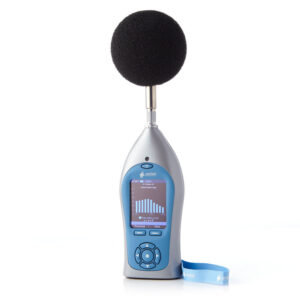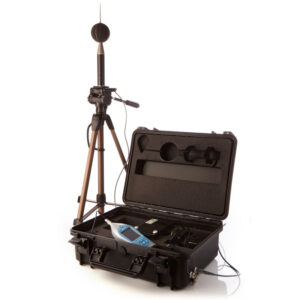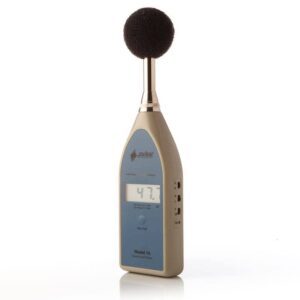Environmental Noise Products from Pulsar Instruments™
-

7-year
Warranty
Nova Environmental Sound Level MeterFrom: £2,439.00 (Ex. VAT/GST) -

7-year
Warranty
Pulsar Nova Outdoor Noise Measurement SystemFrom: £1,610.00 (Ex. VAT/GST) -

7-year
Warranty
Digital Noise Meter for Noise Level TestingFrom: £315.00 (Ex. VAT/GST)
Environmental noise pollution is a major issue in most countries, especially in areas of high population it can cause a noise nuisance for people. In fact, noise pollution is one of the most complained about aspects of our daily lives because it directly affects the quality of life and health of people (and animals) living in the vicinity of a problem noise source.
In October 2018 the World Health Organisation (WHO) published their findings from an international investigation into how much noise affects us. It concluded that it is one of the top environmental hazards to both physical and mental health and well-being in the European Region; and where noise levels are unacceptable people become stressed, annoyed and suffer from sleep deprivation, which experts fear will lead to adverse health effects on their heart (cardiac) and mental health. This report builds on a study undertaken in 1996 by the EU which resulted in a number of Directives aimed at increasing the level of information about Environmental Noise across the EU and the need for more industries to monitor their impact.
Causes of Environmental Noise
Many of the demands of modern society result in the creation of noise, such as increased noise from road traffic levels, larger airports, increased construction in towns and cities of housing and industry. As our green spaces disappear and brown-field sites are redeveloped, noise inevitably becomes closer to where people live and work resulting in more noticeable noise impacts on people.
Typical noise sources
- Industrial Sites
- Construction Work
- Road Traffic
- Animals (Dogs barking)
- Aircraft noise
- Entertainment venues
- Power stations and wind turbines
- Hospitality
Characteristics of Environmental noise
Continuous
- Extraction Fans, compressors etc.
- Road traffic
- Industrial Processes
Intermittent
- Transport
- Construction
- Animals
- Industrial Processes
Broadband
(Noise that has a fairly even tone content and less annoying)
Tonal Noise
(Noise that has dominant tone(s) that can be very annoying)
- ‘Whining’ machinery
- Low-frequency noise that causes vibration within surrounding buildings etc.
- Wind turbines
How to assess environmental noise
In terms of assessing the impact of environmental noise pollution, we need to be able to make suitable noise measurements either in the short term or in some cases, monitor noise levels for longer periods. Such noise assessment and monitoring is different from measuring other types of noise for example, workplace or industrial noise:
- With Workplace and Industrial noise measurements are an exact science, as you are interested in assessing specific noise levels and relating these to legislative or noise action levels.
- Although legislation for man-made environmental noise is in place in most countries to govern legally accepted noise levels, measuring noise nuisance or noise pollution can be very different because the level of annoyance or noise nuisance is subjective and will elicit diverse reactions from different people. In the UK, the most common standard for rating sound from fixed plant affecting nearby noise-sensitive premises is BS 4142: 2014.
Types of environmental noise monitoring include:
- Boundary Noise Assessments
- BS4142 Industrial and Commercial Noise
- Noise Complaints
- Railway and Traffic Noise
- Construction Noise
- Industrial Process Noise
- Hospitality Noise
1. Basic noise level checks or ‘spot checks’
Often you need to take quick decisions and understand if there are likely to be any noise issues.
By using a simple handheld digital noise meter such as the Pulsar Model 14 you have a cost-effective, compact and ‘easy to use’ noise meter that can be easily transported, allowing you to make a quick judgment regarding noise levels. This is particularly useful where a more expensive instrument would be cumbersome and more prone to the risk of damage or misuse.
The Pulsar Model 14 is supplied with a carrying pouch, windshield as standard to protect the microphone capsule and has two selectable ranges to allow you to quickly gauge both environmental and industrial noise levels. The instrument is compliant with IEC 61672-1: 2013 and can be supplied with an acoustic calibrator if you wish to verify your measurements – as really should be done.
2. Single but more detailed measurements
Environmental requirements and legislation vary based on your country, locality and specific circumstances.
We recommend our Class 1 Pulsar Nova Environmental Meter (Model 45) or the Class 2 (Model 46) Nova Octave Band sound meter for carrying out environmental noise assessments. Often these handheld sound level meters are mounted on a tripod at a boundary position and measurements are taken at timed intervals over a set duration. Such a series of similar ‘fixed duration’ noise monitoring measurements can be stored into the instrument’s memory for subsequent analysis. Our integrating sound level meter, the Pulsar Model 33 can also be successfully used for this.
3. Longer-term environmental noise monitoring
Sometimes we need to monitor noise levels on an ongoing level and make longer measurements sub-divided by shorter measurement durations such as 5 minutes, 15 minutes or 1 hour.
This allows us to look at, for example, a 24 hour period and find the average, background or maximum noise levels for every 15 minute period throughout the day. This gives us a much clearer picture of noise patterns and how they can be controlled to minimise their impact on the wider community. Often, lower noise limits will be set during the late evening and night due to the extra impact of any noise. For example, both Class 1 and 2 Nova sound level meters have a removable pre-amp which enables the meters to be used with microphone extension cables.
If you want to measure boundary noise for example, then you will need an outdoor noise measurement kit which is weatherproof to transform your sound level meter into an outdoor monitor, or our special Nova Outdoor Noise Measurement kit which turns our Pulsar Nova sound meters into a longer-term, outdoor monitoring system.
Tonal Analysis
There are many engineering solutions available to reduce noise levels and by performing a 1:3 Octave Band Analysis before and after this work you can determine and report the effectiveness of such improvements.
